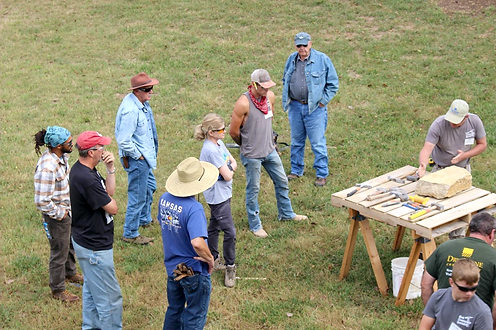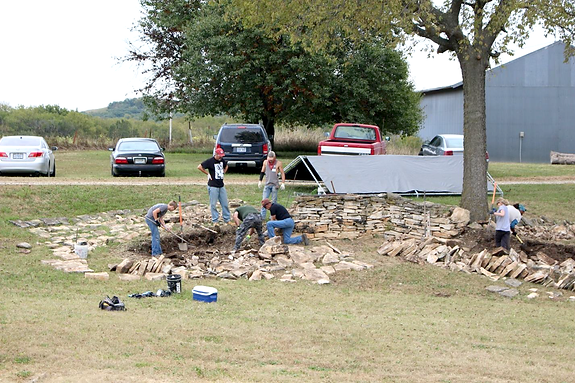Kentucky's Dry Stone Conservancy Visit Wabaunsee County
Folks driving on Old K10 Road the first weekend in October might have noticed a group of athletic-looking students listening to instructors in front of the long retaining wall/fence parallel to the road. They may or may not have noticed the flying banner announcing The Drystone Conservancy (DSC) from Lexington, KY. Wabaunsee County had visitors from Kentucky!
The Executive Director and a master stonemason came to Wabaunsee County to lead an introductory workshop in drystone fence repair and restoration. With some knowledge of the Grimm-Schultz Farmstead, as imparted to them from Luke Koch, Cottonwood Falls drystone mason and business owner, the DSC had studied photographs of the Farmstead with its long run of limestone, estimated to be sixty yards, and had reached the determination that this fence would provide opportunity for their particular expertise to be taught to paying participants. DSC liked that the Farmstead had gained listing on both the state and national registers of historic places in the agricultural category. The stone was in place; although there were clearly stretches of weakness and deterioration in the fence. But there was additional stone on the land to be used for rebuilding and repair of Farmstead outbuildings.
On the first morning after a long truck drive, Jane Wolley, Executive Director, and Neil Rippingale, Scotsman and master stonemason, inspected the fence with Luke. They walked it, they analyzed it, they paced it. They debated in an effort to understand this historic fence built by the Henry Grimm family in the 1880s and preserved by the Leland Schultz family. Above all, they wanted this fence to maintain its authenticity as a Flint Hills example of vernacular architecture. Flint Hills stonework has its own peculiarities. DSC wanted to preserve that character.
Having already built fences in the Tallgrass Prairie Preserve for the Nature Conservancy and the National Park Service, the DSC understood the character of the limestone, as well as the style of building stone fences in the Flint Hills. Without doubt, he admired the relationship between the Main House, finished in 1880, and the long running fence clearly visible to all who pass by on Old K-10 Road to the north. The positioning of the fence was attractive, if not seductive, to the viewers, but it also had an important purpose to allow clear access to the underground duct between it and the road.
Class started on Saturday morning at 8:30 sharp with a presentation of slides, discussion of architectural drawings, distribution of written materials that included a published field guide, and energetic discussion by Jane and Neil. Safety was stressed with anticipated hazards described and addressed. Luke took everyone out to the front of the house to give a hands-on demonstration of tools and their appropriate use and safe handling.
The first job was to disassemble the weak parts of the eastern wall for the repair. As the two teams worked, they discussed the character of each stone in terms of use for the rebuild. The work was tough, and the cool misty rain was welcome to a degree. After a hearty lunch, the teams built dimensional guides of string for the rebuilding. The stones picked for the rebuilding were laid out in a pattern for choice, purpose, and position. Additional rock from the Farmstead was added to the array.
The second day had momentum from the start to finish within the daylight hours. Fatigue was present; but now the teams had bonded and working rhythmically in tandem to complete their section. On the final day, observers came to watch but did not interrupt the teams. Re-assembly of the wall by the teams only stopped for hydration breaks or a sweet/salty snack as the clock ticked.
Chairwoman Marsha Ericson of Native Stone Scenic Byway and instructor Rocky Slaymaker graciously came to visit, to observe, and to tour the Farmstead. The Byway has completed 22 stone workshops in Wabaunee County. Cooperation is the shared goal!
The end result needs to be viewed, but the special feature of the “wall end” looks solid and sturdy, and this image tells more than multiple paragraphs. Here is that wall end! The Farmstead hopes to host additional workshops on various stone topics in 2022 with the DSC right in Wabaunsee County. We welcome them again!
Photos courtesy of Frank McCoy and Colleen Nilson


The End Wall

